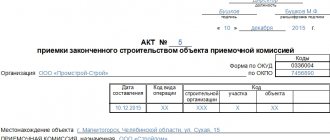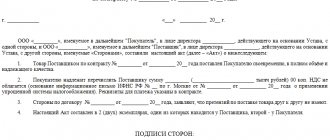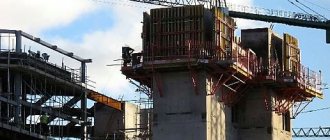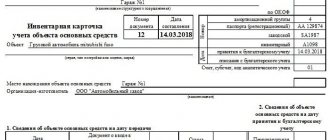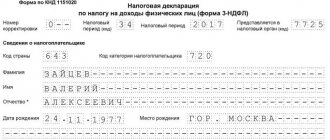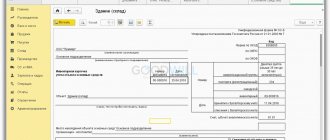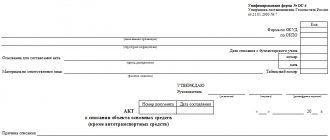Form KS-11 is a unified form of act, which indicates that any construction project is completely completed and ready for operation. It is filled out only after the construction customer has carried out the appropriate check and documented the results of all inspections, tests and measurements performed. It is this information that forms the basis of the act in form KS-11.
- Form and sample
- Free download
- Online viewing
- Expert tested
FILES
Why is the KS-11 act needed?
The completed form of the KS-11 act indicates that the property (residential/non-residential building/structure) has been built or the work on its technical re-equipment (reconstruction) has been completed.
IMPORTANT! Before presenting a document for payment, you should check whether the KS-11 form contains signatures not only of the contractor’s representative, but also of the customer or other competent persons (for example, an investor).
Form KS-11 is issued after the customer has checked and documented all measurement results (inspections, tests). This information should form the basis of the completed building acceptance certificate. Documentation is attached to the act, which the customer subsequently transfers to the owner of the object upon acceptance.
Read about another document drawn up after a comprehensive examination of the constructed facility in the material “Unified Form No. KS-14 - Form and Sample.”
Find out how to properly keep records of completed construction in ConsultantPlus. Study the material by getting trial access to the K+ system for free.
Points 9 to 11
This part conventionally includes points 9-11.
Clause 9. Here you need to refer to the application (i.e. indicate its number), which contains information about acts of acceptance of equipment installed at the site;
Clause 10. There should be a link to the application, which indicates acceptance certificates, certificates, etc. documents on communications included in the construction project.
Clause 11. This small table contains information about all other work carried out on landscaping, improvement of roads, sidewalks, construction of sports, play, and utility buildings related to the main object of the completed construction (with a clear indication of the units of measurement, volume and deadline for the work).
What is accompanied by the act
As for the list of attached documents, the information regarding it is contradictory. The album of unified forms (approved by Decree of the State Statistics Committee of November 11, 1999 No. 100), which contains both the KS-11 form itself and instructions for its use, refers to the list of documentation contained in the Temporary Regulations on the Acceptance of Completed Construction Facilities. However, in accordance with the letter of Rosgosstroy dated October 31, 2001 No. SK-5969/9, the previous letter of the department, which recommended this Temporary Regulation for use, was canceled. In this regard, the list of necessary documents must be agreed upon by the parties when concluding the contract.
Based on the act, the contractor submits to the statistical office information that the construction of the facility has been completed and all contractual obligations have been fulfilled. In these reports, the asset put into operation is shown in the period when such a fact was recorded (meaning the fact of commissioning).
After this, the above fact is brought to the attention of municipal executive authorities. Moreover, this is already done by the real estate user or the construction customer.
Page 2
The eighth paragraph of the acceptance certificate can be highlighted as a separate section. It includes two tables. The first of them contains six columns and concerns any construction projects, with the exception of residential buildings.
Column 1. Here you need to enter the name of the main indicator of the construction project: power, productivity, capacity, production area, volume, throughput, number of jobs, length, etc.
Column 2. Here you need to indicate the unit of measurement of the previous indicator (square meters, cubic meters, etc.)
Columns 3-6. These columns contain information about how many total units of measurement for each previously specified indicator the given object includes according to the project and actually.
The second table is filled in only if the construction project was a residential building. It has four columns, which also contain specific indicators and units of measurement with the values that were prescribed in the development project and those that actually turned out.
Form KS-11 - download or compose yourself
Form KS-11, which is included in the album of unified forms (Resolution No. 100), is approved by another regulatory document - Resolution of the State Statistics Committee of October 30, 1997 No. 71a. However, it is the same form.
You can download KS-11 (form) on our website.
Due to the fact that since 2013, unified forms are not mandatory for use, any company can use its own developed form. But the difference between unified forms is the optimal number of indicators they contain necessary to document the results of an object inspection. The KS-11 sample we offer below for downloading refers to just such convenient and relevant forms.
Filling procedure
To correctly fill out the KS 11 form, you must adhere to the following rules:
- In the header of the document you must indicate:
— serial number of the act (if available); — name and date of preparation of the document; — name and main codes of the compiling organization (necessary for maintaining the company’s financial statements, including paying taxes); — Full name of representatives of the customer and the contractor of construction work;
- the name of the constructed/reconstructed property and the address of its location;
- data from related organizations, which:
— a permit for the construction of the specified property has been issued; — design documentation was developed; — design and estimate documents were approved; — the initial data necessary for the construction of the property has been provided; — other work has been completed (subcontracting companies);
- start and completion dates of construction and installation work and equipment installation;
- indicators of the constructed structure:
- if construction/reconstruction of a premises is carried out that is not intended for permanent residence of people, then option A is filled in, in which it is necessary to indicate such indicators as (if any): - power; — productivity; - length; — area of production premises; — capacity; — throughput; - volume; — the number of jobs provided, and so on; - if a building belonging to the housing stock has been built or has undergone major repairs, then option B is filled in and the following parameters are indicated (if any): - total area of the building; — number of floors in the building; - volume of construction, including underground floor; - area of extensions; - the number and area of apartments equipped in the house;
- For any buildings, additional characteristics must be indicated, which relate to such aspects as:
— installed additional equipment; — hot and cold water supply systems; — gas supply; — sewer network; - heating system; — energy supply; - elevator; — landscaping of the local area; — laying roads and sidewalks; — equipping with outbuildings for domestic purposes; — installation of sports grounds and children's playgrounds, and so on;
- the cost of work including VAT, which is necessary to determine the tax base, including UTII;
- a list of documents that confirm all the data stated in the act (drawn up as an appendix);
- additional conditions (full acceptance of the building or acceptance of a separate part of the building provided for by the project);
- signatures of the parties.
Results
Form KS-11 - acceptance certificate for a completed construction project - is issued upon completion of construction work. The unified form contains all the details required for the primary document. But the contractor has the right to develop the form independently.
Sources:
- Resolution of the State Statistics Committee of November 11, 1999 No. 100
- Resolution of the State Statistics Committee of October 30, 1997 No. 71a
You can find more complete information on the topic in ConsultantPlus. Free trial access to the system for 2 days.
Sample and example of filling out an act of completed construction of an object
The main provisions of the acceptance certificate are:
- name and address of the construction site constructed at the initiative of the customer;
- name of company:
- Issued permission for the construction of the specified property.
- Developed and approved design documentation for construction.
- Conducted research or survey activities before issuing a building permit.
- Subcontractor involved in construction activities.
- period of construction work performed by the order executor;
- description of the capital structure;
- list of communications and additional equipment installed at the construction site;
- cost of work performed.
It is recommended to attach to the completed document, certified by the signatures of representatives or management of the contractor and the customer:
- a list of organizations that, under a subcontract agreement, took part in the construction of the specified facility, indicating the list of operations performed;
- as-built documentation, including a set of drawings, on the basis of which the building was constructed/restored;
- documents that confirm the quality of materials used in construction;
- acceptance certificates for individual premises, units or units;
- acts confirming the testing of individual systems;
- passports for equipment installed inside the building;
- conclusion of supervisory authorities on the compliance of the building with established safety standards.
What it is
Act KS-11 is a fact of confirmation of the manipulations performed and the basis for settlements between the customer and the worker in accordance with the agreement.
The KS-11 act is drawn up in several copies so that it is enough for all citizens who took part in the execution of the contract, and it is signed by the contractor and the customer.
The acceptance procedure is carried out by the customer, based on the results of the check, inspection, testing, measurement, documentation, submitted work, where the finished type of object must comply with the project and recommendations, standards, regulations, and also the conclusion of the supervisory organization.
Based on document KS-11, the contractor, in accordance with the established legal procedure, presents reporting documentation on the fulfillment of the obligations specified in the contract. The commissioned house must be recorded in the reporting documents during the period when the fact of commissioning of this object was completed.
ATTENTION! The person operating the structure or the customer has the right to register the commissioning of the facility with the executive authorities at the location of the property, in accordance with the general procedure.
Reception and delivery of completed work
Here you need to provide a link to the document on the basis of which the initial design data was issued. Costs, additional conditions and signatures of the parties The last part contains mostly only numbers. Point 12-13. Here the numbers indicate the final cost of the construction project according to the design and estimate documentation (broken down by the cost of construction and installation work performed and the cost of equipment, tools and inventory).
It is drawn up in the required number of copies and signed by representatives of the work performer (general contractor) and the customer or another person authorized by the investor for the work performer (general contractor) and the customer, respectively.
The acceptance certificate is the basis for the final payment of all work performed by the contractor in accordance with the agreement (contract).
Acceptance certificate for a capital construction project
An act is a form of legal legal confirmation of a transaction between the transferring and receiving parties. Sometimes a third party may also participate, in whose presence the transaction under the deed is completed. This acceptance certificate for a capital construction project can be downloaded for free in doc format. It was developed in accordance with the regulations of the current legislation of the Russian Federation. Instructions have also been developed in which a standard template can be filled out. See the completed example below.
Sample
The form for filling out the acceptance certificate for a capital construction project is usually drawn up by two parties. With rare exceptions, a third party is present. A document is drawn up by a special commission, which issues permission to put the construction project into operation. The commission includes a contractor, a person acting as a developer, and a customer of services. The act of acceptance of the construction project fully confirms the fulfillment of all contractual conditions for capital construction.
Sometimes there may be deviations from the project. The reasons are indicated. The document contains the address, area, number of floors, length, capacity, number of jobs and other data that differs depending on the object. If additional documentation is attached, it is mentioned in the act.
Compilation rules
The acceptance certificate for a capital construction project consists of several points:
- Write the full name of the act, date, month and year of inspection.
- Enterprise address.
- All contact information, tax identification number, checkpoint are recorded.
- Personal information of all commission members, certification number, telephone numbers, etc.
- A description of the organization is given, including tax identification number, checkpoint, initials of the director, contact phone numbers.
Then comes the main part, which also consists of several points that necessarily require step-by-step completion:
- Purpose and grounds for drawing up the act.
- Dates.
- Methods of collecting information.
- A list of documents related to the financial and economic activities of the enterprise that were studied by the inspectors.
- The location of the control is indicated.
- Collection of evidence.
- Conclusion – conclusions of the control commission, summarizing the evidence. Reporting results to the management of the enterprise.
All completed copies of the form, including copies, are signed by both parties and then stamped.
As an appendix, documents must be attached that prove the readiness of the facility for commissioning.
Usually attached:
- documents with technical characteristics of main structures;
- test reports;
- checking hidden work;
- diagrams and geodetic surveys;
- laboratory test certificates, etc.
Necessity
The main purpose is that it becomes the main document that confirms the acceptance of the construction operations performed. This means that all construction-type work has already been completed, that is:
- a new house has been created;
- or an old building has been renovated.
The legal significance of the document is that after signing it you can:
- make all payments for the work carried out on the construction of the building;
- prove the fact of acceptance of the transfer of work in the event of litigation.
The importance of this act in construction cannot be underestimated.
Sample and Form 2021
The document must be drawn up in accordance with all the requirements stipulated by the rules. To make it easier to understand the features of entering data, you can focus on the example presented below.
And here is a blank document form.
NOTE. The act does not allow any corrections, blots, torn sheets of paper, marks “Believe as corrected” or cross-outs. If incorrect data is entered, it is necessary to replace the damaged sheet. The text should be checked several times before final signing.
Sample of filling out KS-11 by paragraphs and pages in 2021
To fill out an acceptance certificate for a completed construction project, certain requirements must be met. This document consists of several pages, the points of which must be remembered in full compliance with the norms of legislative acts.
Filling out the first sheet
The first part contains information about the performer. Filling out any document begins with the design of the “header”. First you need to indicate the serial number of the act. Next, you need to indicate the date of compilation of this document, and it is important to post the corresponding values in the correct columns. This applies to both the date under the document name and in the upper right part.
After this, you need to indicate the full name of the legal entity involved in the construction of the construction project, as well as its OKPO. Next, the last name, first name and patronymic of the responsible persons are indicated, both on the part of the customer and on the part of the contractor.
Information on the conditions for signing the KS-11 act
The second part, by and large, provides detailed information about the completed construction of the facility.
Clause 1. Intended for entering data on the name of the construction project, indicating the detailed address where it is located (region, city, district, street, house number).
Clause 2. The state body that issued the permit for the construction of the transferred facility is indicated.
Clause 3. Intended for entering data about subcontractors - companies that took part in the construction of the facility in addition to the general contractor.
Clause 4. Enter the name of the organization that was involved in the preparation of design and estimate documentation. Companies that additionally took part in the development of the project are also indicated here.
Clause 5. A reference to the document on the basis of which the design data was issued is indicated.
Clause 6. Intended for entering the name of the organization that approved the design and estimate documentation, usually this is the customer.
Clause 7. The timing of construction work is indicated.
Filling out the second page
Point 8. Consists of two tables, so it is worth considering in more detail.
First table:
Column 1. Intended for the main indicator of a construction project: throughput, number of jobs, capacity, power, production area, etc.
Column 2. The unit of measurement is indicated: square meters, pieces, cubic meters, etc.
Column 3-6. The number of units of the main indicator that were in the design documentation and actually turned out is indicated.
The second table is filled out only if the transferred object is a residential building.
Third page
Clause 9. The number of the application is indicated, which displays the acceptance certificates for the equipment installed at the site.
Clause 10. Indicate the number of the application, which contains acceptance certificates, certificates and other documents on communications.
Clause 11. There is a table that indicates all the work to improve the local area: landscaping, laying asphalt, installing playgrounds, etc.
Litigation in connection with the signing of certificates of completion of work under a construction contract
Legal regulation of the acceptance of work under a construction contract is provided for in Articles 720 of the Civil Code of the Russian Federation (general provisions on construction contracts) and 753 of the Civil Code of the Russian Federation (provisions on construction contracts).
At the same time, the mandatory drawing up of an act upon acceptance of work is provided only for a construction contract (clause 4 of Article 753 of the Civil Code of the Russian Federation). Article 720 of the Civil Code of the Russian Federation does not contain a requirement to formalize the results of acceptance under a work contract in writing. However, the certificate of completion of work can be used by the parties as written evidence in court (Article 75 of the Arbitration Procedure Code of the Russian Federation, Article 71 of the Code of Civil Procedure of the Russian Federation). In addition, drawing up a written document allows you to unambiguously record the date of acceptance of the work, which is essential for determining the moment when the risk of accidental destruction of the work passes to the customer (Article 705 of the Civil Code of the Russian Federation) and the occurrence of the customer’s obligation to pay for the work (Clause 1 of Article 711 of the Civil Code of the Russian Federation) .
A certificate of completion of work is a document signed by the customer and the contractor, which records the fact and results of acceptance of the work.
It should be borne in mind that, according to established judicial practice, the act records the contractor’s performance of his obligations under the contract and cannot be considered as a transaction within the meaning of Art. 153 Civil Code of the Russian Federation. For this reason, the act cannot be declared invalid according to the rules on the invalidity of transactions (Resolution of the FAS Volga-Vyatka District dated March 22, 2012 in case No. A4329613/2010, Resolution of the FAS Moscow District dated July 29, 2010 No. KG-A41/7506-10).
In this regard, a subsequent challenge by one of the parties to a construction contract (customer or contractor) of the certificate of work performed previously signed by the parties (for example, according to the unified forms KS-2 and KS-3) cannot be carried out according to the rules of invalidity of transactions. In this case, the customer or contractor must file claims in court, for example, for monetary recovery of the cost of work actually performed under a construction contract, for recovery of damages, for reimbursement of their expenses for eliminating defects, when the customer’s right to eliminate them is provided for in the construction contract (Article 397397 Civil Code of the Russian Federation), and others. When considering the listed and other claims, questions are raised about the discrepancy between the signed acts of work performed and the actual circumstances.
The fact that acts of completed work are not transactions also means that their preparation does not require compliance with the procedure provided for in Art. 78-79 of the Federal Law of December 26, 1995 No. 208-FZ “On Joint Stock Companies” for concluding major transactions (Resolution of the Federal Antimonopoly Service of the North-Western District of March 20, 2009 in case No. A05-3246/2008). Likewise, when drawing up an act, the rules on concluding large transactions in a limited liability company (Article 46 of the Federal Law of 02/08/1998 No. 14-FZ “On Limited Liability Companies”) and the rules for concluding interested party transactions (Article 81- 84 of the Federal Law of December 26, 1995 No. 208-FZ “On Joint-Stock Companies”, Article 45 of the Federal Law of February 8, 1998 No. 14-FZ “On Limited Liability Companies”). Let us note that the fact that the act of completed work is a transaction is denied not only in judicial practice, but also in the legal literature (Ershov O.G. Signing the act of acceptance of the result of construction work: transaction, transaction-like or actual actions? // “Law and Economics”, 2012 , No. 7).
Chapter 37 of the Civil Code of the Russian Federation does not contain requirements for the form of the work completion certificate. In paragraph 4 of Art. 753 of the Civil Code of the Russian Federation, which regulates the acceptance of work under a construction contract, only states that the delivery and acceptance of work is formalized by an act signed by both parties.
The forms of acceptance certificates for certain types of work are contained in by-laws. For example, Resolution of the State Statistics Committee dated November 11, 1999 No. 100 approved unified forms of primary accounting documentation, including forms KS-2 and KS-3 for acceptance of construction and installation work and confirmation of their cost. From January 1, 2013, the forms of primary accounting documents contained in albums of unified forms of primary accounting documentation are not mandatory for use. At the same time, forms of documents used as primary accounting documents established by authorized bodies in accordance with and on the basis of other federal laws (for example, cash documents) continue to be mandatory for use (information of the Ministry of Finance of Russia No. PZ-10/2012).
Resolution of the State Committee of the Russian Federation on Statistics dated October 30, 1997 No. 71a approved forms KS-3 “Certificate of the cost of work performed and expenses”, KS-6 “General log of work”, KS-11 “as unified forms of primary accounting documentation.” Certificate of acceptance of a completed construction facility”, KS-14 “Acceptance certificate of a completed construction facility by the acceptance committee.”
The parties may use the form determined by the head of the customer or contractor in accordance with Part 4 of Art. 9 of the Federal Law of December 6, 2011 No. 402-FZ “On Accounting”. They can also use the form of a universal transfer document recommended by the letter of the Federal Tax Service of Russia dated October 21, 2013 No. ММВ-20-3 / [email protected] And yet, in practice, when completing construction work, the most common use of the unified forms KS-2 provided for by the parties to the contract , KS-3 and KS-14. We believe that with this use, a reference to the acceptance of construction work on the basis of unified acts must necessarily be contained in the construction contract.
If during acceptance the customer finds shortcomings in the work, he has the right to indicate them in the certificate of completion of work (clause 2 of article 720 of the Civil Code of the Russian Federation). When signing the act, the customer may not have the technical ability to include information about the shortcomings of the work. This is possible if the act was prepared by the contractor and does not contain the corresponding section or in the case where the parties provided for the use of the KS-2 form established by Order of the State Statistics Committee of November 11, 1999 No. 100, which also does not provide columns for indicating deficiencies. In such a situation, the customer should refuse to sign the act indicating the reasons for the refusal (detection of deficiencies) and provide information about the deficiencies in a separate document, which, in accordance with clause 1 of Art. 720 of the Civil Code of the Russian Federation must be handed over or sent to the contractor.
In judicial practice, there are three different positions on the issue of the consequences of signing a certificate of completion of work without any comments. Thus, there is a position according to which signing a certificate of completion of work without comments may deprive the customer of the right to refer to defects in the work in the future. There is another point of view, according to which the customer in this situation is deprived of the right to refer only to obvious shortcomings. According to the third position, the presence of certificates of completed work, signed without comments, does not deprive the customer of the right to present his objections regarding the volume and quality of the work performed.
The personal practice of the author of the publication shows the validity of the contractor’s references to the signing at one time by the customer, without any comments, of acts of forms KS-2 and KS-3, the use of which was provided for by the parties to the contract. Representing the interests of the contractor, we drew the attention of the arbitration court that, according to the forensic construction examination carried out, the identified deficiencies were removable and obvious in nature and could have been detected using the usual method of acceptance. By accepting the work without inspection and signing the act, the customer subsequently deprived himself of the opportunity to refer to deficiencies that could have been identified during the inspection (obvious deficiencies), since otherwise was not established by the contract (clause 3 of Article 720 of the Civil Code of the Russian Federation). In the dispute presented here, the arbitration court recognized our arguments as justified. The customer’s claim was denied, and the court’s decision “stood” in higher courts.
For the sake of objectivity, it should be noted that the later judicial practice of the cassation instance of the Far Eastern District began to interpret the same provisions on the application of the same provisions of the law differently. Thus, in the decision of the Arbitration Court of the Far Eastern District dated September 11, 2018 No. F03-3304/2018 in case No. A73-3602/2018, the court stated the following:
“The argument of the cassation appeal about the customer’s acceptance of the work performed in the absence of comments is subject to rejection, as based on an incorrect interpretation of the norms of Article 723 of the Civil Code of the Russian Federation, since the shortcomings are obvious, since the presence of acts of work performed, signed without comments, does not deprive the customer of the right to present his objections regarding the volume and quality of work performed (paragraphs 12 and 13 of the Information Letter of the Presidium of the Supreme Arbitration Court of the Russian Federation dated January 24, 2000 No. 51 “Review of the practice of resolving disputes under construction contracts”). A similar approach is set out in the Resolution of the Presidium of the Supreme Arbitration Court of the Russian Federation dated April 22, 2014 No. 19891/13...”
Within the framework of this position, the courts, as a rule, proceed from the fact that the signing of acceptance certificates for completed work without comments in itself cannot indicate recognition by the customer of high-quality work (but we draw the attention of readers to the fact that in the above fragment of the decision of the Arbitration Court of the Far Eastern district of September 11, 2018 No. F03-3304/2018 we are talking not only about the quality, but also about the volume of work performed). And the presence of such acts, signed without comments, does not deprive him of the right to present his objections to the court regarding the quality of the work. In this case, the customer, who accepted the completed work without comments, can subsequently prove its poor quality by presenting an expert opinion. The customer’s refusal to carry it out may result in failure to prove the contractor’s improper fulfillment of his obligations.
Courts generally recognize only the certificate of completion of work as proper evidence of the contractor’s performance of work, which is why disputes often arise about its proper execution and content. Thus, according to the definition of the Supreme Arbitration Court of the Russian Federation dated August 12, 2011 No. VAS-10240/11 in case No. A41-1001/10, acts drawn up or sent after the termination of the contract are not evidence of the completion of work (in this case, the definition concerned a subcontract agreement, but the same the conclusions can be extended to general contracting agreements and other construction contracts). In another example from practice, acts that were signed outside the designated column intended for the signature of the contractor and the customer (that is, in fact, did not contain the signatures of the contractor and the customer), the court did not recognize as evidence of work completion (resolution of the Federal Antimonopoly Service of the West Siberian District dated 06/01/2009 No. F04-3006/2009 (7132-A70-44) in case No. A70-3151/6-2008).
In the event of a dispute, the certificates of completed work signed by the parties to the contract must be compared in terms of the scope and content of the work not only with the text of the construction contract and its annexes (where, as a rule, the content of construction and repair work is reflected in the specifications), but also with the texts additional agreements to the contract concluded during its execution (often numerous).
Thus, in one of the court cases, while defending the interests of the contractor, we were faced with the customer’s position, which denied both the number of bored piles installed by the contractor at the construction site, and the fact that the customer disputed the location of these piles at the site as not corresponding to the design estimates documentation. The exact number of piles at the site was determined by the forensic construction examination carried out in the case, on which we insisted and which was carried out by the arbitration court of first instance only after the judicial acts were canceled by the court of cassation. As for the location of the piles, we drew the attention of the arbitration court to the fact that their location corresponds to several design changes (there were eight in total) submitted to the contractor by the customer. So the piles stood where they needed to be, where the customer indicated they should be placed, having changed the design he had submitted.
As a result, we can draw a line under a small study of law enforcement practice and try to determine the meaning of acts of work performed under construction contracts.
These acts are characterized by the fact that they:
· are documents that record the fact and results of acceptance of work;
· record the contractor’s performance of his obligations under the contract;
· are the basis for the customer’s obligation to pay for the work;
· cannot be considered as a transaction within the meaning of Art. 153 of the Civil Code of the Russian Federation, and therefore cannot be challenged according to the rules of invalidity of transactions and do not require approval according to the rules for approving transactions;
· can be drawn up in any form chosen by the parties to the contract (the law does not contain requirements for the form of the work completion certificate);
· the reports may contain references to deficiencies discovered by the customer in the work performed by the contractor;
· are important for determining the moment of transfer to the customer of the risk of accidental loss of work;
· act in judicial practice as the appropriate and main evidence of the contractor’s performance of work.
MIKHAIL SLEPTSOV
, ATTORNEY, MANAGING PARTNER OF THE LAW OFFICE "SLEPTSOV AND PARTNERS", CANDIDATE OF LAW, ASSOCIATE PROFESSOR, HONORED LAWYER OF THE RUSSIAN FEDERATION
Source of publication: information monthly “The Right Decision” issue No. 07 (201) release date of 07/22/2019.
The article was posted on the basis of an agreement dated October 20, 2016, concluded with the founder and publisher of the information monthly “Vernoe Reshenie” LLC “.
